I got a Yashica Mat a year ago, just to try out medium format film photography. I got bitten hard, and I now use film as much as digital. The Yashica is compact, lightweight and fun to use; it's a perfect second camera, but as a main camera it has some shortcomings. I'd like a rugged camera with high quality interchangeable lenses and preferably a waist-level finder like the one on the Yashica. Oh, and I prefer a large 6x6 or 6x7 format over 6x4.5; if I use film I may as well use the largest format I find practical. I did consider the Mamiya 7, but it's a rangefinder and known to be somewhat delicate. The Hasselblad 500 system is fairly light and high quality but it's very expensive even used. The Mamiya RB and Bronica systems are large and bulky, and really intended for studio use.
Instead I got a used Pentax 67 with a 90/2.8 lens. It's a manual-focus 6x7 format SLR camera with a body style similar to that of a 35mm camera. This camera system has been around for a long time; it was introduced in 1969 (the same year I was born) and has been in production right up until 2009. Production of the third and last generation will stop in September; parts, lenses and second-hand gear will no doubt be plentiful for decades to come. My camera is a second generation one, introduced in 1989.
Instead I got a used Pentax 67 with a 90/2.8 lens. It's a manual-focus 6x7 format SLR camera with a body style similar to that of a 35mm camera. This camera system has been around for a long time; it was introduced in 1969 (the same year I was born) and has been in production right up until 2009. Production of the third and last generation will stop in September; parts, lenses and second-hand gear will no doubt be plentiful for decades to come. My camera is a second generation one, introduced in 1989.
Some people will say the Pentax 67 is huge and heavy; others will say it's compact and lightweight (and all will agree that it's rugged and solid, and has a noisy shutter with lots of vibration). This mixed reputation is due in large part because of its looks. It invites comparison to 35mm SLR cameras, and compared to them it's absolutely huge, like a giant-sized or novelty version of a normal camera. It's heavy too - about 1.7kg with the prism viewfinder, two or three times as much as most 35mm film cameras. Small-format users find it enormous.
To most medium and large-format camera users, on the other hand, it's fairly compact and portable. There is no other 6x6 or larger medium format SLR camera that is as light and compact, and probably none other as rugged. The camera is designed to be a field camera as much as studio equipment, and it's been a long-time favourite of landscape photographers and astro-photographers, hikers and travelers especially. With a waist-level finder the camera is closer to 1.2kg (the glass prism in the prism finder weighs half a kilo by itself), and the 90mm normal lens is again fast and small.
It may look big sitting right next to a small 35mm SLR, but it's really not bulky or cumbersome to bring along; certainly no more so than any other 6x7 format camera.
Besides, when you compare it to current digital SLR cameras it's no longer all that big. The current digital Canon and Nikon flagships - the 1Ds and the D3X - are about the same size and weight as this camera, but a lot more expensive and fragile, and needing multiple batteries or a charger and frequent access to electricity.
The design is clean and basic, and largely unchanged since 1969. Manual focus, aperture and shutter speed, manual film advance (thumb crank) and manual film loading - no motor drives or automation here. There is a prism finder with a light meter meter available for the 67 model I have, but it only meters passively: you set speed and aperture manually and get feedback from the meter. The newest model - the 67 II - does have a modern matrix meter with aperture-priority mode, but only as a prism finder. I prefer a waist-level finder and like to use an external meter anyway so I didn't want to spend a premium for the latest model. Film loading is easy, and it loads and unloads exactly the same way the Yashica Mat does. I mean exactly; you could write one set of detailed instructions covering both cameras.
Back street in Kobe. The residential areas up towards the mountain side often look like this, with a mix of new buildings, traditional Japanese houses and old European architecture. As a major port, Kobe has long had a large influx of foreign residents, and affluent traders built their mansions and residences up on the mountainside rather than near the dingy, smelly harbor. The remaining old European-style buildings are now protected and the ones along the main streets are mostly converted to restaurants and wedding chapels, but the ones along the back streets are still used as family residences.
To me, this camera - the 6x7 format, the near-normal angle of view, the waist-level finder - is perfect for shots like this. You can relax with the camera hanging in front and just wait until you see the picture you want on the large, clear ground glass.
This is an SLR (single lens-reflex) camera with a focal plane shutter (a curtain just in front of the film, covering it), just like your normal SLR or DSLR camera. It has a mirror in front of the shutter that reflects the light from the lens onto the viewfinder screen. When you press the shutter, the mirror first swings up, then the shutter curtains move across the film plane to expose the film. As anyone who's used a 35mm SLR or DSLR camera knows, this design can be a little noisy as the mirror swings up, then the shutter snaps across the film or sensor. The film format here is bigger - almost 6x7 cm in size - so it means the mirror and shutter is also much bigger, heavier and noisier.
To put a not too fine a point on it: the camera is loud. Not the high-pitched metallic click of a small-format camera, but a distinct, heavy "Flubbupp" from the mirror and a solid "Ka-lock" from the shutter. Nobody nearby is in any doubt that A Picture Was Taken. And you're in no doubt yourself either; all that fast-moving mass really shakes the camera in your hands as the shutter fires. Like most SLR cameras the Pentax 67 has a mirror lock-up function; it is a really good idea on this camera.
This is Kusumu, an Indian restaurant housed in a dingy, unmaintained 3rd floor apartment in an old concrete building in Kobe. The wallpaper is flagging, the floor buckles, the furniture, cutlery and decorations are mismatched and second hand, and at least part of the place is clearly used as living space for the family that runs it. Next door they have another apartment where they're selling Indian imported ingredients such as spices, rice and lentils in bulk.
The food, however, is cheap, home-cooked (literally) and delicious. There is no menu, just the meal of the day. You get samosa as a starter, then a plate with rice, three kinds of curry and chapati, which you get as much of as you want (in fact it's hard to stop the steady flow of food). In a sign of just how good it is, normally fastidious young Japanese women seem to come here in droves despite the messy, unkempt environment.
This image - taken on a tripod - pushes my scanner to the limit. It's about 35mp as scanned, and there's more detail on the film than the scanner is able to pick up. No matter; it's more resolution than I know what to do with anyway.
With that said, people exaggerate the problem of shutter and mirror shake. Yes, it does give you a bit of added vibration, but it only really start to matter at slower shutter speeds (1/30 and slower) where you really should be using a tripod and mirror lock-up anyhow. At 1/125 and faster there seem to be no such problems at all. Other large medium-format SLR cameras have the same design issue but don't have the same reputation; I suspect the noise makes people believe the problem is worse than is really the case. There is apparently a specific, real issue with long lenses (200 mm and beyond) and shutter speeds from 1/15 where the shutter can make the setup oscillate unless you have the body and lens anchored to the tripod at two points rather than just one. As I normally only use normal and wide lenses it's a non-issue for me.
Ritsuko is making a point of me spending too much time taking pictures, I think. Or she just wanted a shot titled "Oddball Foreign Guy With Oversize Camera".
Anyway, this shows one reason to shoot negative film: The white wall is sunlit while the inside of the parking garage is in deep shadow. And yet, the wall is not blown out but has lots of detail and the dark garage is not blocked. This is, take note, after I've actually increased the total contrast to make the sunlit feeling stronger. A digital camera would have given you pure white walls or solid black shadows.
In practice it's really comfortable to use. The weight is no more than my usual K10D and a set of lenses, and it fits into my usual camera bag. It's not a fast camera by any standards however (no MF camera is), so it's not well suited for quick snapshooting. You just can't focus and frame a picture fast enough to follow a rapidly unfolding event. A better way is to decide beforehand where to take an image, set the camera, then wait until the light, the people and other elements come together. You get to decide exactly what background and elements you get in your image, and you give yourself time to prepare. Of course more often than not I never get the combination of elements I was looking for - or the idea turns out not to work at all once I see the result.
Neat & Grog, a tequila bar in Shinsaibashi, and an occasional waterhole for me and Ritsuko. Haru, the owner, is an entertaining guy, and the variety of tequilas he's got is amazing.
In this case I really wanted a more interesting-looking passersby in the image, but I was losing the light (see how long the shadows are on the front) and in another minute or two the front would have been in shadow. Can't get what you want, always.
This sit-and-wait approach is very suited for a waist-level finder. You focus once, then let the camera hang from the neck strap when you frame and take the picture. When you use a tripod (and you really should), the waist-level finder is much easier and faster to use than a prism finder. An added benefit is that you're not hiding your face behind the camera so people don't react negatively to you. The camera is big, of course, but despite the size of it and the racket it makes it still looks like a plain old film camera, so people don't feel threatened by it.
A tripod, just to repeat it once again, is a really good idea. You can certainly use the camera hand-held and the results will be fine as long as you stay at 1/125 or faster. Those speeds will still benefit from a tripod, adding just that extra bit of crispness (resolution) to the image, and at slower speeds - 1/30 or slower - some kind of steady support is really no longer an option. Besides, when you're doing sit-and-wait photography a tripod is a lot more comfortable than holding the camera yourself. This goes for your digital camera too, by the way: use a tripod and you'll immediately see an improvement in the quality of your pictures, but especially when you zoom in or when it's getting dark.
At this point I have only the 90mm f/2.8 lens. It's the smallest lens available and one of the fastest. The coverage is about the same as a 45mm lens on film or 31mm on a DSLR; the Yashica, the Voigtländer and the Handy Box all sport lenses with similar coverage. It's the focal length I use most often by far so I'm in no hurry to get another one. At some point I would like a really wide lens, like the 45mm f/4, but that is for later. The 90mm will do me fine until I've learned to use this camera fully.
You perhaps saw this shot in an earlier post. Just wanted to test flash photography with the Pentax 67, and it's easier to just do a self-portrait than ask Ritsuko. Out of focus (I'm sitting too close) but otherwise OK.
The Pentax has a flash sync speed of 1/30, which means you have to use 1/30 shutter speed or slower. This is one of the few real drawbacks on this camera. By way of comparison, my Pentax DSLR will sync at up to 1/180, and the Yashica, with its leaf-shutter, will sync all the way to 1/500. A slow sync speed means you can't use a flash in combination with daylight to fill in shadows for instance. For real indoor ("studio") use like here the only light is from the strobes so the sync speed doesn't really matter.


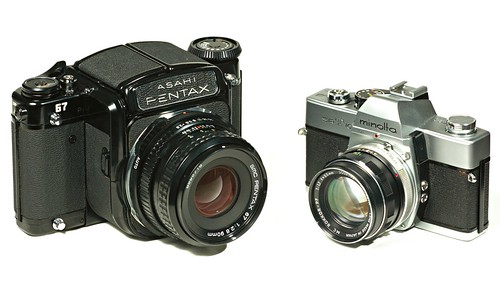
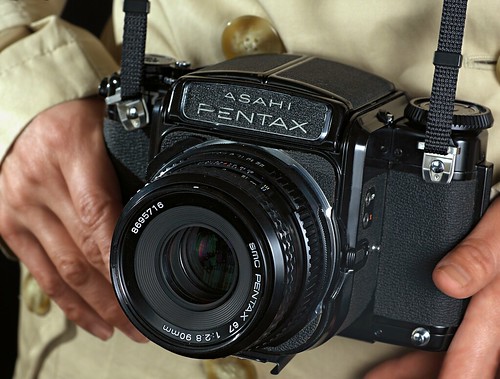

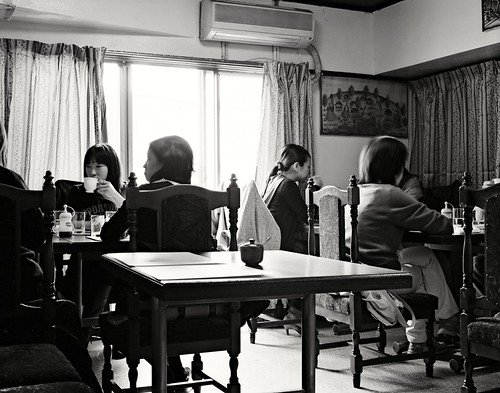
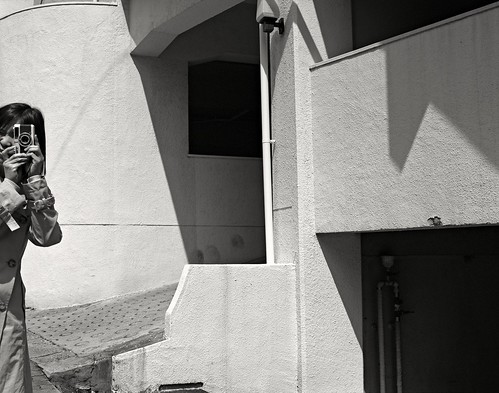
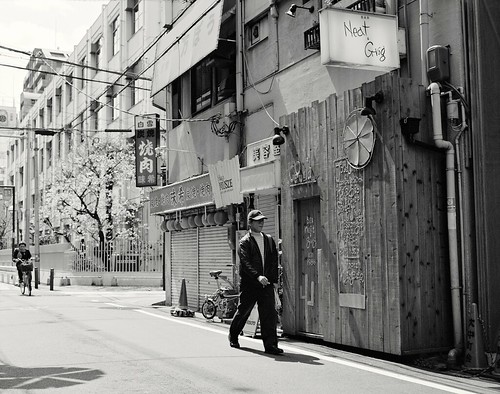
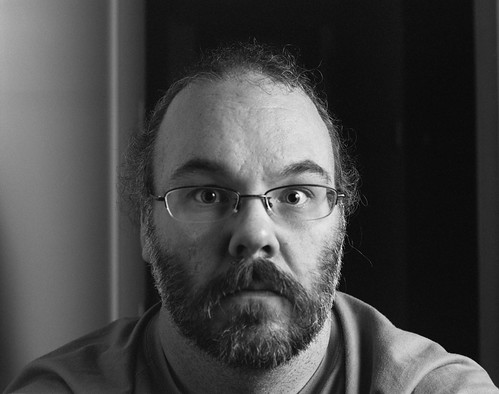
This is an excellent post. I love your images from this wonderful camera!
ReplyDeleteHi -
ReplyDeleteLong time lurker. :-)
I've been using the P67 for ... over 15 years now. Just the one body, but with 45, 105 and 300 lenses; the 105 is actually the fastest that Pentax made, f2.4, but is larger than the 90.
One area it was used widely was fashion photography, especially with the longer lenses. I was walking in Paris once and happened upon a photoshoot: 600mm f4 lens on a P67, the model was about 100 feet away. Biggest tripod I have ever seen...
I used a Fuji 645 and 69 for a while, you should take a look at these if you come across one. Fantastic lenses (but fixed and rangefinder!), but awesome quality. They were my travel cameras for several years before I decided I needed interchangeable lenses. :-)
Sad to say that I haven't used the P67 is about 3 years: Olympus DSLR with Oly glass (E510) is simply too good. But you simply can't beat a 60x70 inch print from the P67...
Great blog, enjoy reading it when I can...
:-)
Hi -
ReplyDeleteMe again. Forgot to mention: my youngest daughter is in Wakayama-shi, right around the corner from you. :-) She's enjoying learning Japanese and has had her first earthquake experience... :-)
Hi John, roentarre, and thanks for the comments!
ReplyDeleteJohn, I chose the 90mm over the 105 partly because it's a fair bit smaller and a little bit wider, and the difference between 2.4 and 2.8 really is nothing you'd notice. I mostly got it because that was the lens attached to the camera when I bought it, of course.
What is your experience with the 45mm? I'm really considering getting one, but I'm not sure what using such a wide lens is like on this camera and what the results are like. Not too interested in longer lenses; that's where small format cameras really shine. If a 600mm would fall in my lap, it'd be a really long lens on my Pentax DSLR (of course, if it really did fall in my lap, I'd have to postpone using it until I got home from the hospital ^_^ ).
I have looked at the Fuji rangefinders and they're neat (local camera stores always have a good supply of used ones). They're also quite large, however. If I were to recommend any compact MF camera today it'd be the new Fuji folder (if you can afford it), the Bronica rf645 or possibly the Yashica Mat (if you don't need interchangeable lenses). The Fuji 6x9 format ones seem to be just about as bulky as the Pentax 67 to take along in practice.
You should take out the Pentax 67 again - it's a joy to use. I really appreciate the way it slows me down and makes me think. Today, with good scanners and powerful software, processing film is really easier than ever. I scan the negatives, and from that point my workflow is the same whether the image comes from my K10D, my cellphone or one of the film cameras.
The major difference is perhaps that I have to go through a hundred images from the K10D each time to get three or four I really like; with the MF film cameras I only go through a dozen or less and still end up with three or four shots I'm decently happy with. Shooting film is slower but in the end I spend less time making a good film image than a digital one.
Hi -
ReplyDeleteThe 45mm rocks. It is the lens with the widest angle of any MF system that remains rectilinear, and if there is any distortion I've not been able to measure it. Serious piece of glass, 72mm filter, which it shares with the 300, which is good, since a decent filter set (UV, 25A, Polarizer, etc etc etc) costs some real money, especially the pol in a thin mount to avoid vignetting.
I'm contemplating pulling the 67 back out, but to do purely B&W, developing myself (old hand with that), but I lack a decent scanner: the price for MF scanners remains outrageous, unless you take the Epson flatbed route, and even so that's a chunk of change (not to mention a serious chunk of desktop space as well).
John
Hmm, you're not making it any easier for me to avoid getting the 45mm. I just might have a look around the used camera shops in the neighborhood next week...
ReplyDeleteI've yet to really use any filters at all for film cameras (I do use a polarizer for my DSLR). If I did get a polarizer for the 90mm lens it does have the same filter size (67mm) as the 50-135 I got for my DSLR, but, as you say, it's not exactly inexpensive. I should probably look into a few color filters for BW shooting though. Yellow and red are the most common, right? You shouldn't bother with UV filters. Most modern films are not very sensitive to UV (neither are digital sensors), and most "UV filters" have been shown to not actually block UV very well at all in any case.
I do mostly shoot BW with film - I did use one roll of slide film last week though; I wish my pictures could look like these do when seen on a light table - and I develop myself. I have a lot more fun slowly developing and processing half a dozen film shots than when I spend my time sorting through hundreds of mediocre digital shots at a time.
The scanner is a problem, I agree. Dedicated scanners for medium format (the Nikon 9000 is pretty much the only "consumer level" one) are hideously expensive. But a flatbed scanner is not a bad choice for MF. I use the Epson V700, and it does a better job than I expected; I can (just) pull out about 35mp from a 6x7 format negative, and that's more resolution than I can really comfortably process anyhow (1Ghz processor and 2Gb memory is just not beefy enough). Many people use the cheaper V500 and are happy with its results too. A V500 doesn't cost more than a second-hand lens after all, or a few 77m filters, so it's not all that bad.
I did try a really cheap scanner (we have one of those printer/scanner/copier combination thingys at home, with a film scanning lid lamp) and the results are not good - I couldn't use it for posting web-sized images. If that scanner (which does a good job with printing and scanning documents) is representative of what people try to use with film then no wonder they get turned off by it.
Hi -
ReplyDeleteI use the UV simply to protect the lens, old habit. Filters are cheaper than front elements, and given the knocks my equipment gets on the road, this has saved a front element at least 6-7 times (happens when scrambling up rock cliffs to get get a better view, swing it the wrong way and crunch: time to get a new filter...)...no one seems to make simple protective glass filters, hence the UV choice, as it avoids the very slight color shift of the 1A filters...
The 25a is probably the first to get: for B&W it will turn your skies black (blocks blue), rendering sunny days with decent clouds very dramatic. It also reduces skin blemishes in portraits significantly, almost taking it to orthochromatic levels. And that might be a real treat for you: orthochromatic film, which lacks a red-sensitive component. Hard to find, but extremely fine grained, usually.
The V700 is the scanner I'd get if I were to buy one today...
I use a hood rather than a filter for protection. The filter vs. hood argument seems older than dirt; we probably have to settle it with pistols at dawn or something if we ever happen to meet.
ReplyDeleteAnyway, thanks for the filter tip. Thought the red filter seems a bit extreme (losing three stops is not peanuts) so I picked up a YA3 filter instead, as that seems a bit more generally useful. I'll probably get the red one as well in due course, though. And thanks for all the tips in general.
Pillowcases at 50 paces is more my style. :-)
ReplyDeleteHi! This blog entry with those fantastic B&W shots of yours was one of the inspirations for me when I decided to buy into the Pentax 67 system. Just got the first batch of scans shoot with the Pentax 67. Quality so far is far from yours.
ReplyDelete:( Could you please disclose what kind of film (at what ISO) did you use, and how did you develop?
Hi Bela! This was actually Ilford XP2, at iso400. That's a B&W color film if that makes sense. In other words, it's the same kind of film as negative color film (called C-41), but it records only BW, not color. That way it can be developed by any lab just like a color film. If you use a lab this is much cheaper than having them develop real B&W. It is a very good film in its own right, and because it's a negative film you have less visible grain too.
ReplyDeleteI shot, had the negatives developed, then scanned the images myself.
What film did you use and what is the problem?
Damn you, Janne! Months ago I read this blog entry of yours and I made a mental note to come back to it. I've actually been coming back over and over again until my cravings could only be cured by my own acquisition of a Pentax 67.
ReplyDeleteNow I am also an owner of a Pentax 6x7, squiggly happy like a pig. I opted for the 75mm f/4.5 as I prefer it a little wider. What a wonderful outfit this is!
I am also eyeing a waist-level finder but I do like the convenience of an in-built light meter. So now I have the TTL-metered finder which is incredibly accurate so far given that its design probably dates back 30 years.
I posted a little report of my first outing with this behemoth over in the Pentax forum at dpreview which might interest you.
I envision to use the 6x7 much more frequently than my K10D. I also have quite a few options here in New York to get non-C-41 film developed and scanned in reasonable quality and at passable prices.
And it's all your fault! ;-)
"And it's all your fault! ;-)"
ReplyDeleteI do what I can to bring people over to the dark side ^_^ It's a fun camera, and while words like "compact" or "pocketable" isn't really applicable to it, it's a very good for walkarounds.
I use an exeternal meter - in fact, I've somewhat gotten into the habit of using it even for my K10D. So I have no problem with the lack of metering with the waist level finder, and I appreciate that the camera becomes quite a bit lighter and smaller without the prism.
Have fun, and don't be frustrated if the first couple of rolls doesn't end up as well as you hoped.
Howdy there Janne,
ReplyDeleteJust joining into the 67 club. I am tickled with excitement waiting for my first B/W to come back.
So far i have this neat little outfit -
http://www.flickr.com/photos/knumbnutz/3770655576/
and have just added a handle.
I actually love going to manual. Sometimes its just too easy with a dslr to take too many images instead of really getting it right. This actually forces you to do that and more so not to waste as well. I think it will actually improve my images of course its a little too early to say :-)
Glad to see others out there enjoying the P67 and i hope to see your images sometime from this beast.
Cheers Neil
I've been using my P67 for a little while now, got the body real cheap, the original first gen one.
ReplyDeletePicked up the 105 cos I read so many good things about it, and sure enough.. I love it.
Finally got my hand on some lugs, gonna get me a comfortable strap, and need to find a waist level finder.
Can't wait to take it to Japan in November to really get the most out of this.
Great stuff! I've been using a Pentax 67 system (first the 67ii until it died and now the 67) for about 15 years, mainly for outdoor nature stuff...using Velvia transparency film. I recommend the 45mm lens- super sharp. I am now looking for an inexpensive scanner- may look into the Epson V700.
ReplyDeleteI have the 67 with ttl prism on lug strap 55mm f4 and shoot handheld kodak tri x and develop in rodinal print in darkroom with 100mm schneider 5.6 lens so simple. easy to use down to 60th sec. Awesome prints. Also shoot kodak 400vc colour negative film and print as big as a house.Which second lens to get? 200mm?
ReplyDeleteWhat lens depends on what you want to shoot of course. Overall I would say, though, that it tends to get hard to handhold over 200mm. That's about the limit for a simple tripod setup too; above that you need to start thinking about extra support to dampen oscillations.
ReplyDeleteI got a 165/2.8, since it's the longest fast lens for the system, and I'm pretty happy with it. The focal length works very well for tighter street shots and landscapes.
hi Janne,
ReplyDeletei stumbled upon your blog while looking for a parts diagram of the 67. i just wanted to share that i enjoyed reading about your adventures, and want to thank you for taking the time to write about them.
pleasant journeys. :)
whisky
Whisky, thanks for the kind words! I'm writing just because it's fun to write, but I'm really happy when I hear somebody enjoys the blog.
ReplyDelete